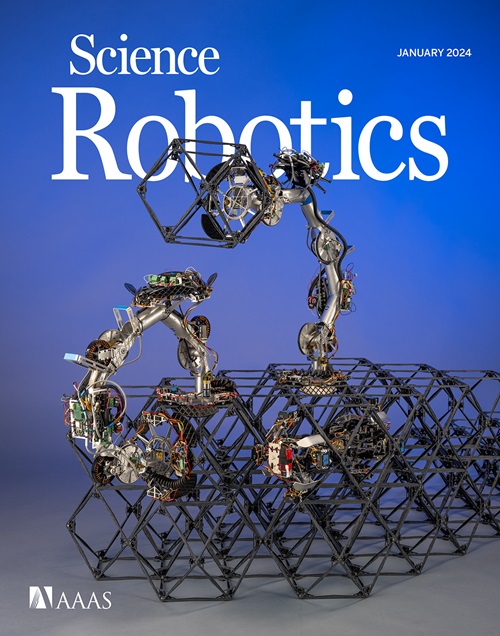Acrobatics at the insect scale: A durable, precise, and agile micro–aerial robot
IF 27.5
1区 计算机科学
Q1 ROBOTICS
引用次数: 0
Abstract
Aerial insects are exceptionally agile and precise owing to their small size and fast neuromotor control. They perform impressive acrobatic maneuvers when evading predators, recovering from wind gust, or landing on moving objects. Flapping-wing propulsion is advantageous for flight agility because it can generate large changes in instantaneous forces and torques. During flapping-wing flight, wings, hinges, and tendons of pterygote insects endure large deformation and high stress hundreds of times each second, highlighting the outstanding flexibility and fatigue resistance of biological structures and materials. In comparison, engineered materials and microscale structures in subgram micro–aerial vehicles (MAVs) exhibit substantially shorter lifespans. Consequently, most subgram MAVs are limited to hovering for less than 10 seconds or following simple trajectories at slow speeds. Here, we developed a 750-milligram flapping-wing MAV that demonstrated substantially improved lifespan, speed, accuracy, and agility. With transmission and hinge designs that reduced off-axis torsional stress and deformation, the robot achieved a 1000-second hovering flight, two orders of magnitude longer than existing subgram MAVs. This robot also performed complex flight trajectories with under 1-centimeter root mean square error and more than 30 centimeters per second average speed. With a lift-to-weight ratio of 2.2 and a maximum ascending speed of 100 centimeters per second, this robot demonstrated double body flips at a rotational rate exceeding that of the fastest aerial insects and larger MAVs. These results highlight insect-like flight endurance, precision, and agility in an at-scale MAV, opening opportunities for future research on sensing and power autonomy.
昆虫级杂技:一种耐用、精确、敏捷的微型空中机器人
空中昆虫由于体积小,神经运动控制迅速,因此非常敏捷和精确。它们在躲避捕食者、从阵风中恢复、或降落在移动物体上时,都表现出令人印象深刻的杂技动作。扑翼推进有利于飞行敏捷性,因为它可以产生瞬时力和扭矩的大变化。翼虫的翅膀、铰链和肌腱在扑翼飞行过程中,每秒承受数百次的大变形和高应力,突出了生物结构和材料的优异柔韧性和抗疲劳性。相比之下,亚克微型飞行器(MAVs)的工程材料和微尺度结构的寿命要短得多。因此,大多数亚图飞行器的悬停时间限制在10秒以内,或者以较慢的速度跟随简单的轨迹。在这里,我们开发了一种750毫克的扑翼微型飞行器,它显示出大大提高了寿命、速度、准确性和灵活性。通过减少离轴扭转应力和变形的传动和铰链设计,该机器人实现了1000秒的悬停飞行,比现有的亚图mav长两个数量级。该机器人还进行了复杂的飞行轨迹,平均误差小于1厘米,平均速度超过每秒30厘米。该机器人的升重比为2.2,最大上升速度为每秒100厘米,其双体翻转的旋转速度超过了最快的空中昆虫和大型无人机。这些结果突出了在大规模MAV中类似昆虫的飞行耐力,精度和敏捷性,为未来的传感和动力自主研究开辟了机会。
本文章由计算机程序翻译,如有差异,请以英文原文为准。
求助全文
约1分钟内获得全文
求助全文
来源期刊

Science Robotics
Mathematics-Control and Optimization
CiteScore
30.60
自引率
2.80%
发文量
83
期刊介绍:
Science Robotics publishes original, peer-reviewed, science- or engineering-based research articles that advance the field of robotics. The journal also features editor-commissioned Reviews. An international team of academic editors holds Science Robotics articles to the same high-quality standard that is the hallmark of the Science family of journals.
Sub-topics include: actuators, advanced materials, artificial Intelligence, autonomous vehicles, bio-inspired design, exoskeletons, fabrication, field robotics, human-robot interaction, humanoids, industrial robotics, kinematics, machine learning, material science, medical technology, motion planning and control, micro- and nano-robotics, multi-robot control, sensors, service robotics, social and ethical issues, soft robotics, and space, planetary and undersea exploration.
 求助内容:
求助内容: 应助结果提醒方式:
应助结果提醒方式:


